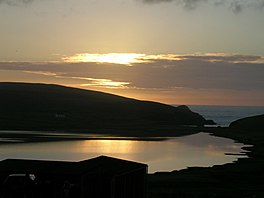Loading AI tools
Lake in the United Kingdom From Wikipedia, the free encyclopedia
The Lochs of Spiggie and Brow are located west of Boddam in the parish of Dunrossness, in the South Mainland of Shetland, Scotland, about 6 km north of Sumburgh.
| Lochs of Spiggie and Brow | |
|---|---|
 Sunset over the Loch of Spiggie | |
| Location | Dunrossness, Shetland, Scotland |
| Coordinates | 59.93273°N 1.33622°W |
| Max. width | 0.5 miles (0.80 km) |
The lochs are designated as a Special Protection Area and a Site of Special Scientific Interest for wildlife conservation purposes.[1] The site has also been identified as an Important Bird Area (IBA) by BirdLife International because it supports wintering waterfowl, including whooper swans.[2]

The Loch of Spiggie was historically a voe (Shetland Dialect: fjord or inlet) in which a sand bar formed, cutting off the sea.[1] It is considered "the only moderately large loch" in the South Mainland of Shetland, and is the fourth longest loch in Shetland. It is roughly rectangular, with the longest dimension approximately north–south, and the maximum width is almost 0.5 miles (0.8 km);[3] its area is roughly 1 km2.
The loch is an RSPB nature reserve. The loch supports many species of birds, including lapwing, tufted duck, redshank, snipe and whooper swan. Additionally, various seasonal visiting birds also make use of the loch – in spring, long-tailed duck and skylark; and in summer, Eurasian oystercatcher, Eurasian curlew, mallard, arctic tern, black-legged kittiwake and great skua. The birds breed in the marshes and farmland next to the loch.[1]
The Loch of Brow is a smaller loch, about 0.25 km2 in area, lying to the south-east of the Loch of Spiggie, into which it outflows.[3]
The remains of a broch can be found on a small island in the loch. It used to be accessible by a number of stepping-stones which formed a "rough causeway"; however, these now lie 2 feet (0.6 m) under water. The remnants of a circular hollow approximately 8.5 metres (28 ft) in diameter can be seen, which is thought to have been the interior lining of the broch. A small portion of an outward-facing wall was excavated at the north end that suggested the broch's walls may have been between 3.5–4.0 metres (11–13 ft) thick.[4]
Seamless Wikipedia browsing. On steroids.
Every time you click a link to Wikipedia, Wiktionary or Wikiquote in your browser's search results, it will show the modern Wikiwand interface.
Wikiwand extension is a five stars, simple, with minimum permission required to keep your browsing private, safe and transparent.